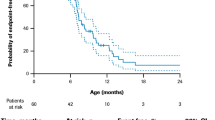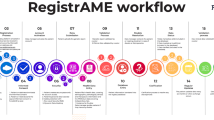Abstract
Spinal muscular atrophy (SMA) is an autosomal recessive genetic disorder characterised by the degeneration of motor neurons and progressive muscle weakness. It is caused by homozygous deletions in the survival motor neuron gene on chromosome 5. SMA shows a wide range of clinical severity, with SMA type I patients often dying before 2 years of age, whereas type III patients experience less severe clinical manifestations and can have a normal life span. Here, we describe the design, setup and utilisation of the TREAT-NMD national SMA patient registries characterised by a small, but fully standardised set of registry items and by genetic confirmation in all patients. We analyse a selection of clinical items from the SMA registries in order to provide a snapshot of the clinical data stratified by SMA subtype, and compare these results with published recommendations on standards of care. Our study included 5,068 SMA patients in 25 countries. A total of 615 patients were ventilated, either invasively (178) or non-invasively (437), 439 received tube feeding and 455 had had scoliosis surgery. Some of these interventions were not available to patients in all countries, but differences were also noted among high-income countries with comparable wealth and health care systems. This study provides the basis for further research, such as quality of life in ventilated SMA patients, and will inform clinical trial planning.





Similar content being viewed by others
References
Brzustowicz LM et al (1990) Genetic mapping of chronic childhood-onset spinal muscular atrophy to chromosome 5q11.2-13.3. Nature 344(6266):540–541
Lefebvre S et al (1995) Identification and characterization of a spinal muscular atrophy-determining gene. Cell 80(1):155–165
Melki J et al (1990) Mapping of acute (type I) spinal muscular atrophy to chromosome 5q12-q14. The French Spinal Muscular Atrophy Investigators. Lancet 336(8710):271–273
Rochette CF, Gilbert N, Simard LR (2001) SMN gene duplication and the emergence of the SMN2 gene occurred in distinct hominids: SMN2 is unique to Homo sapiens. Hum Genet 108(3):255–266
Lefebvre S et al (1997) Correlation between severity and SMN protein level in spinal muscular atrophy. Nat Genet 16(3):265–269
Gavrilov DK et al (1998) Differential SMN2 expression associated with SMA severity. Nat Genet 20(3):230–231
Soler-Botija C et al (2005) Implication of fetal SMN2 expression in type I SMA pathogenesis: protection or pathological gain of function? J Neuropathol Exp Neurol 64(3):215–223
Parsons DW et al (1998) Intragenic telSMN mutations: frequency, distribution, evidence of a founder effect, and modification of the spinal muscular atrophy phenotype by cenSMN copy number. Am J Hum Genet 63(6):1712–1723
Wang CH et al (2007) Consensus statement for standard of care in spinal muscular atrophy. J Child Neurol 22(8):1027–1049
Mercuri E, Bertini E, Iannaccone ST (2012) Childhood spinal muscular atrophy: controversies and challenges. Lancet Neurol 11(5):443–452
Zerres K et al (1997) A collaborative study on the natural history of childhood and juvenile onset proximal spinal muscular atrophy (type II and III SMA): 569 patients. J Neurol Sci 146(1):67–72
Ogino S et al (2002) Genetic risk assessment in carrier testing for spinal muscular atrophy. Am J Med Genet 110(4):301–307
Ogino S, Wilson RB, Gold B (2004) New insights on the evolution of the SMN1 and SMN2 region: simulation and meta-analysis for allele and haplotype frequency calculations. Eur J Hum Genet 12(12):1015–1023
Feldkotter M et al (2002) Quantitative analyses of SMN1 and SMN2 based on real-time lightCycler PCR: fast and highly reliable carrier testing and prediction of severity of spinal muscular atrophy. Am J Hum Genet 70(2):358–368
Brabec P et al (2009) Characterization of the DMD/BMD patient population in Czech Republic and Slovakia using an innovative registry approach. Neuromuscul Disord 19(4):250–254
D’Amico A et al (2011) Spinal muscular atrophy. Orphanet J Rare Dis 6:71
Benson RC et al (2012) International survey of physician recommendation for tracheostomy for spinal muscular atrophy type I. Pediatr Pulmonol 47(6):606–611
Rul B et al (2012) Tracheotomy and children with spinal muscular atrophy type 1: ethical considerations in the French context. Nurs Ethics 19(3):408–418
Acknowledgments
The authors would like to acknowledge the families of those living with Spinal Muscular Atrophy who have been instrumental in the formation of the SMA national registries. We also acknowledge former and current members of the TREAT-NMD office at the Institute of Genetic Medicine in Newcastle, including Agata Mertyn, Stephen Lynn and Emma Heslop. We also acknowledge the members of the current TGDOC: Jan Verschuuren (Chair), Hugh Dawkins (Chair elect), Anna Ambrosini, Svetlana Artemieva, Alexander N. Baranov, Farhad Bayat, Christophe Béroud, Ria Broekgaarden, Filippo Buccella, Craig Campbell, Nick Catlin, Monica Ensini, Pat Furlong, Kevin Flanigan, Ole Gredal, Lauren Hache, Serap İnal, Jacqueline Jackson, Pierre-Yves Jeannet, Anna Kaminska, A. Ayse Karaduman, Veronika Karcagi, En Kimura, Janbernd Kirschner, Jaana Lähdetie, Hanns Lochmüller, Vitaliy Matyushenko, Vedrana Milic-Rasic, Violeta Mihaylova, Marie-Christine Ouillade, Ian Murphy, Miriam Rodrigues, Rosario dos Santos, Pascale Saugier-Veber, Inge Schwersenz, Thomas Sejersen, Rasha El Sherif, Eduardo Tizzano, Isabela Tudorache, Sylvie Tuffery-Giraud, Jen Wang, Simon Woods, W. Ludo van der Pol, Peter Van den Bergh, and Petr Vondráček. We acknowledge funding provided to the national SMA registries, including: AFM Grant No. 16104, Jennifer Trust for Spinal Muscular Atrophy (2012), TREAT-NMD: EU FP6 contract number 036825 (2007 to 2011), TREAT-NMD Operating Grant: (2012), VUL 317/2007 (Bulgaria), German Ministry of Education and Research, MD-NET #01GM0302 (Germany), Italian Association of Patients with Neuromuscular Diseases (Italy), Neuromuscular Research Foundation Trust (New Zealand), Ministry of Science and Higher Education (641/N-TREAT/09/2010/0 and Ministry statutory grant to the Department of Neurology, Warsaw (Poland), KUKAS (Registry of Neuromuscular Disorders at Hacettepe) and Association Francais contre les Myopathies (AFM), Princes Beatrix Spierfonds and the Spieren voor Spieren Foundation (the Netherlands), Association de la Suisse Romande et Italienne contre les Myopathies (ASRIM), Fondation Suisse de Recherche sur les Maladies Musculaires (FSRMM) and Schweizerische Muskelgesellschaft (Switzerland), International Spinal Muscular Atrophy Patient Registry (Indiana University), which is supported by Families of SMA (USA), Mexican Social Security Institute (IMSS) and Instituto Jalisciense de Asistencia Social, Universidad de Guadalajara, Fundación Hospitales San Javier, The Rotary International, Fundacion Atrofia Muscular Espinal (FUNDAME Spain), GENAME Project (Hospital Sant Pau, Hospital Ramon y Cajal, Hospital La Fe, Hospital Virgen del Rocio, Hospital Sant Joan de Deu and Hospital Valle Hebron), Spain.
Conflicts of interest
Professor Hanns Lochmuller was elected chair of the TREAT-NMD Alliance in April 2012 and is the previous chair of the oversight committee. Professor Lochmuller has a financial interest/arrangement with Pfizer, Ultragenyx and GlaxoSmithKline (Research grant investigator).
Ethical standard
Ethical approval was in place for each of the national registries.
Author information
Authors and Affiliations
Corresponding author
Electronic supplementary material
Below is the link to the electronic supplementary material.
Supplementary Figure S1: SMA registries questionnaire
Rights and permissions
About this article
Cite this article
Bladen, C.L., Thompson, R., Jackson, J.M. et al. Mapping the differences in care for 5,000 Spinal Muscular Atrophy patients, a survey of 24 national registries in North America, Australasia and Europe. J Neurol 261, 152–163 (2014). https://doi.org/10.1007/s00415-013-7154-1
Received:
Revised:
Accepted:
Published:
Issue Date:
DOI: https://doi.org/10.1007/s00415-013-7154-1




